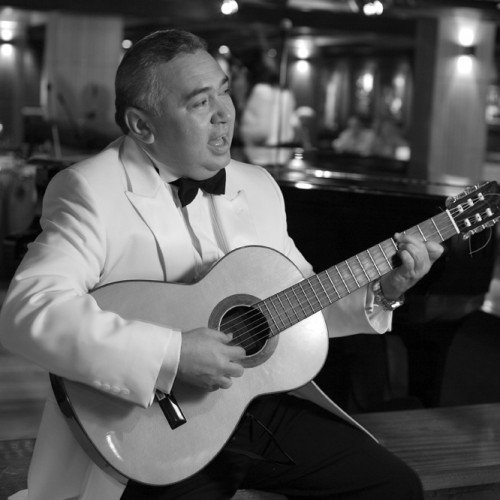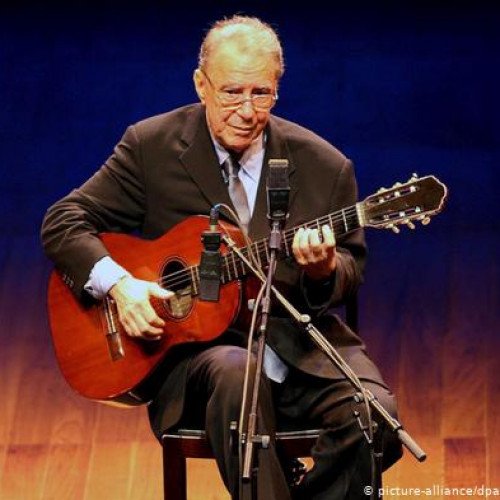Latin American musical genres

Bolero
Bolero refers to two distinct genres of slow-tempo Hispanic music and their associated dances.[1] The oldest type of bolero originated in Spain during the late 18th century as a form of ballroom music, which influenced art music composers around the world, most famously Maurice Ravel's Boléro, as well as a flamenco style known as boleras. An unrelated genre of sung music originated in eastern Cuba in the late 19th century as part of the trova tradition. This genre gained widespread popularity around Latin America throughout the 20th century and continues to thrive. The original Spanish bolero is a 3 4 dance that originated in Spain in the late 18th century, a combination of the contradanza and the sevillana. There are many so-called boleros in art music (i.e., classical music), which are primarily inspired in the original Spanish genre of the same name. Ravel's Boléro is one of his most famous works, originally written as a ballet score commissioned by Ida Rubinstein, but now usually played as a concert piece. It was originally called Fandango but has rhythmic similarities with the Spanish dance form as described in this article, being in a constant 3 4 time with a prominent triplet on the second beat of every bar. Chopin wrote a bolero for solo piano (Op. 19), but its rhythms are more that of the polonaise. He was a close friend of Pauline Viardot, the daughter of the famed Spanish tenor Manuel García, who had introduced the bolero to Paris Léo Delibes wrote a bolero in his Coppélia in Tableau 2. Debussy wrote a bolero in La Soirée dans Grenade Bizet wrote a bolero in Carmen Saint-Saëns wrote a bolero, El desdichado, for 2 voices and orchestra Moszkowski's first set of Spanish Dances (Op. 12) ends with a bolero. Lefébure-Wély wrote Boléro de Concert for organ The bolero from Hervé's Chilpéric has been immortalized in Toulouse-Lautrec's famous painting (above). Friedrich Baumfelder wrote a Premier Bolero, Op. 317, for piano. Richard Aaker Trythall wrote a bolero for four percussionists based on the rhythm and structure of the traditional bolero dance. Trythall imagined the four percussionists as four dancers, intertwining their solos, duets, and trios with moments of group ensemble work in the same way a choreographer might have done. Charles-Auguste de Beriot wrote a bolero in his concerto "Scene de Ballet" for violin and piano (or orchestra). English banjo composer Joe Morley wrote a bolero titled "El Contrabandista" after noted banjoist and composer Alfred Cammeyer published a bolero in 4 4 time for banjo. Morley composed his as a true bolero in 3 4 time. John Serry Sr. composed his African Bolero for accordion and flute in 1950. Fumio Hayasaka composed a bolero for the Akira Kurosawa film Rashomon in 1950.[citation needed] Keith Emerson composed his Abaddon's Bolero for Orchestra and Synthesizer in 1972. In some art music boleros, the root lies not in the bolero but in the habanera, a Cuban precursor of the tango, which was a favourite dance rhythm in the mid-19th century, and occurs often in French opera and Spanish zarzuela of the 19th and 20th centuries.
Statistics for this Xoptio

Bossa nova
Bossa nova (Portuguese pronunciation: [ˈbɔsɐ ˈnɔvɐ] (About this soundlisten)) is a style of samba developed in the late 1950s and early 1960s in Rio de Janeiro, Brazil.[3] It is mainly characterized by "different beat"[nb 3] that altered the harmonies with the introduction of unconventional chords and an innovative syncopation of traditional samba from a single rhythmic division.[5][6] Therefore, the "bossa nova beat", then, is characteristic of a samba style and not of an autonomous genre.[7][8] According to the Brazilian journalist Ruy Castro, the bossa beat – which would be created by the drummer Milton Banana – was "an extreme simplification of the beat of the samba school", as if all instruments had been removed and only the tamborim had been preserved.[9] In line with this thesis, musicians such as Baden Powell, Roberto Menescal and Ronaldo Bôscoli, also claim that this beat is related to the tamborim of the samba school.[10] One of the major innovations of bossa nova was the way to synthesize the rhythm of samba on the classical guitar.[3][8] According to musicologist Gilberto Mendes, the bossa nova was one of the "three rhythmic phases of samba", in which the "bossa beat" had been extracted by João Gilberto from the traditional samba.[7] According to the author Walter Garcia, the synthesis performed by Gilberto's guitar was a reduction of the "batucada" of samba, a stylization produced from one of the percussion instruments: the thumb stylized a surdo; the index, middle and ring fingers phrased like a tamborim.[8] The bossa nova wave came to renew samba and to contribute to the modernization of Brazilian music, being a watershed.[11] The style emerged at the time when samba-canção[nb 4] was the dominant rhythm in the Brazilian music scene.[13][14] Its first appearance was on the album Canção do Amor Demais, in which the singer Elizeth Cardoso recorded two specifically compositions by the duo Antônio Carlos Jobim and Vinicius de Moraes, "Outra Vez" and "Chega de Saudade", which were accompanied by João Gilberto's guitar. It was the first time that the Bahian musician presented the beat of his guitar that would become characteristic of the style.[3] By accompanying Cardoso's voice, Gilberto innovated in the way of pacing the rhythm, accentuating the weak times, in order to carry out a synthesis of the beat of samba to guitar.[3][15] Months later, João Gilberto's first album was released, containing the tracks "Chega de Saudade" and "Bim Bom".[15] Considered the landmark of the birth of bossa nova,[3][15] it also featured Gilberto's innovative way of singing samba, which was inspired by Dorival Caymmi.[16][17] With the LP Chega de Saudade, released in 1959, Gilberto consolidated the bossa nova as a new style of playing samba.[3][5] His innovative way of playing and singing samba, combined with the harmonies of Antônio Carlos Jobim and the lyrics of Vinicius de Moraes, found immediate resonance among musicians who were looking for new approaches to samba in Rio de Janeiro,[3][18] many of them were influenced by American jazz.[19] Then, it emerged an artistic movement around Gilberto and others professional artists such as Jobim, Moraes and Baden Powell, among others, which attracted young amateur musicians from the South Zone of Rio – such as Carlos Lyra, Roberto Menescal, Ronaldo Bôscoli and Nara Leão.